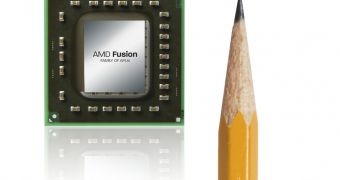Together with its APU and CPU plans for 2012, AMD also made public the company’s 2013 processors roadmap, which includes the Tamesh, Kabini and Kaveri accelerated processing units fabricated using 28nm process technology.
The most important change introduced by AMD with its 2013 APUs is the move to the GCN graphics architecture, which is expected to bring an important increase in computing performance.
According to AMD, this advanced graphics architecture will be used in all of its 2012 APUs, including the low-power Tamesh processor targeting the tablet space.
Destined to come as a replacement for the 2012 Hondo APU, Tamesh will use a system-on-a-chip (SoC) design and will include the “Jaguar” low-power x86 cores.
The chip will also take advantage of the Heterogeneous Systems Architecture (HSA) made possible by the transition to a GCN-based GPU.
Moving to the low power category, here the Kabini APU replaces Brazos 2.0 featuring the same SoC design and “Jaguar” x86 cores as the Tamesh tablet accelerated processing unit.
In the performance processor category, AMD’s third-generation APU, code named Kaveri, will employ “Steamroller” (the evolution of AMD’s “Piledriver” core architecture) x86 cores for enhanced instructions per clock and power advantages.
Applications that take advantage of GPU acceleration will also be able to harness the power of the Heterogeneous Systems Architecture (HSA) of the chip.
As far as the company’s high-end desktop processors are concerned, AMD chose not to provide us with any details, although AnandTech seems to believe that we will see a Steamroller based derivative at some point in the future.
All of the chips AMD plans to introduce in 2012 will be manufactured using the 28nm production process, but AMD hasn’t mentioned who will build these APUs for them.

 14 DAY TRIAL //
14 DAY TRIAL // 
